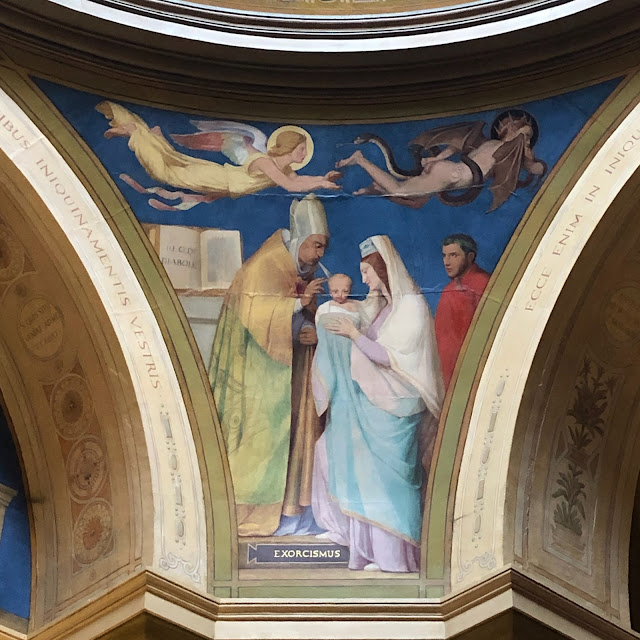All Hallows: Little Devils
 |
| The baptism chapel of Église Notre-Dame-de-Lorette, 9th Arr. |
If you've attended (or participated in) a baptism that welcomes a baby into the Catholic church, you will have noticed that the priest's language explicitly rebukes Satan, asks the child's parents and godparents to do the same, and offers prayers that the child can be freed from original sin. This is in fact a ritual of exorcism. But don't expect the spookshow popularized by William Peter Blatty's 1971 novel The Exorcist, and reinforced by countless derivative (mostly bad) films, books, TV shows, and sham documentaries. No levitating babies with spinning heads or speaking backwards in ancient Aramaic--just a mass celebrated with family and their friends. If you do experience otherwise, I don't need to advise you to contact a young priest and an old priest. You've seen the movies. You know the routine.
Even knowing that baptism is a lower-case exorcism, the upper-case Exorcist book and movie casts a long shadow on the word itself--at least in the US. So it was a bit jarring to see it spelled out in the chapel of Église Notre-Dame-de-Lorette in the 9th Arr., where both Claude Monet and Georges Bizet were baptised.
One of the panels from Adolphe Roger's mural (circa 1830) in the baptism chapel is labeled "exorcismus." It mixes the routine baptism ritual--a priest blessing an infant held by its mother while the father looks on--with an unambiguous depiction of the ceremony's high stakes: an open book reads "recede diabole" ("go away, devil") while a flying angel chases Satan away on the wing.
On the other hand, something about the serpent giving the angel a raspberry with its forked tongue reminds the faithful that the Evil One never goes too far away. As if to illustrate the point, the church's name "lorette"--deriving from the Italian town of Loreto, whose basilica enshrines a house which some believe to have been the BVM's residence--came to evoke temptation and sin, attaching itself as a slang term for the many prostitutes who worked the neighborhood in the late 19th century.
Baptism scenes are not uncommon in European church art--although they usually show Christ's baptism by John (the Baptist, coincidentally enough). Notre-Dame-de-Lorrette is no exception.
Less common are other scenes from Jesus's childhood, like his bris. Luckily, Cathédrale Notre-Dame de Chartres rectifies this situation, with one panel of its spectacular choir screen showing the Jewish naming ceremony of Christ.
 |
| La circoncision (1529), by Jehan Soulas, Cathédrale Notre-Dame de Chartres. |
Depictions of Christ's circumcision--and the feast day to honor the event in the liturgical calendars of different Christian denominations--have gone in and out of favor within the church over the centuries, perhaps reflecting the popularity of the practice among believers. This may explain why Chartres was my first encounter with this scene from Jesus's life, even though it should have been completely anticipated, if I had ever stopped to give it a moment's contemplation.
Now, admittedly, I don't have much in the way of religious education. I learned a bit in graduate school in order have a good understanding of sociology's intellectual origins, and have done some extracurricular readings on things like theodicy, esoteric movements, paranormal thinking, and how different philosophical traditions conceptualize hell, the devil, the black arts, and heresy (relax, they're all the same topic).
And since the role of circumcision in the church has been contentious historically, my limited expertise leaves me uncomfortable going beyond just the tip of such a sensitive matter.
While I don't recall any other depictions of the ritual in sites of religious significance, suffice it to say that I will keep a sharp eye out on any future visits. Perhaps it's been dangling there all along, and I just haven't noticed.



Comments
Post a Comment